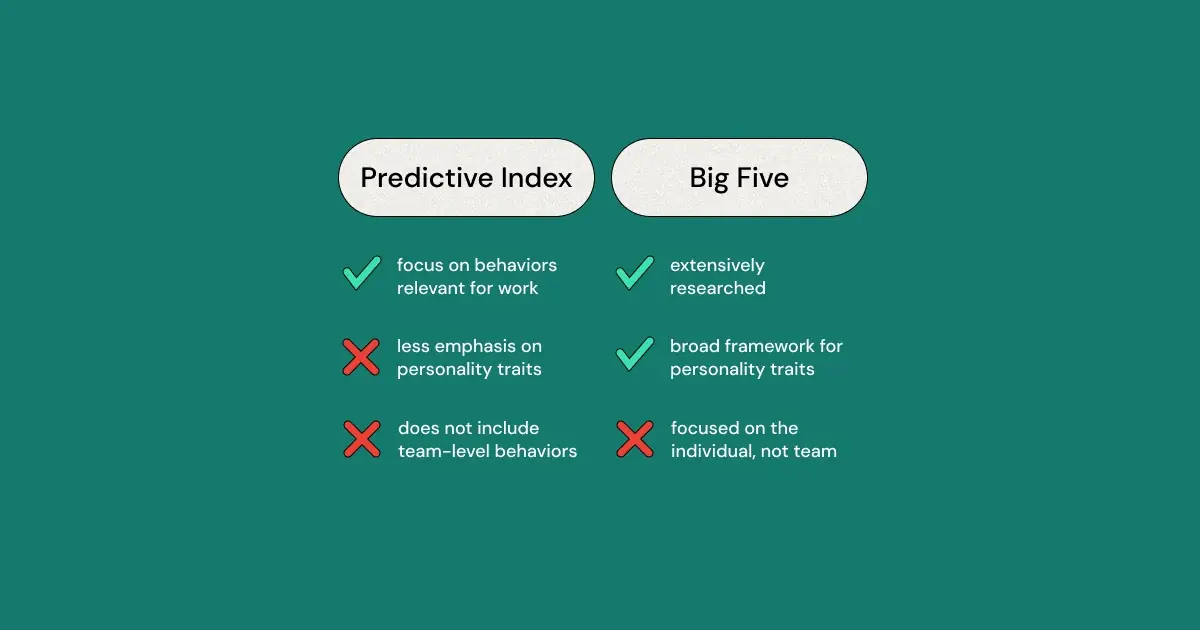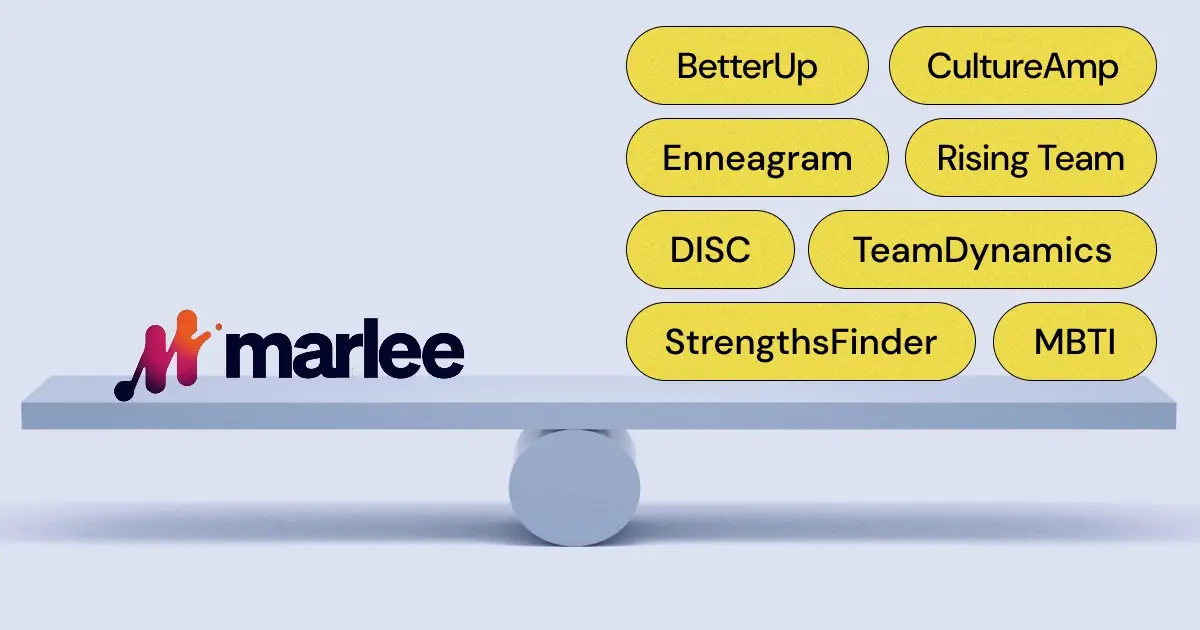Personality assessments play a crucial role in personal and professional development, offering insights into an individual's unique strengths, preferences, and behaviors. With a plethora of personality tests available, choosing the right one can be a daunting task. In this blog post, we will compare two widely used personality assessments: the Predictive Index (PI) and the Big Five Personality Test. We will delve into their histories, methodologies, strengths, weaknesses, and practical applications to help you determine which test is right for you. Furthermore, we'll discuss why these tests may not be the best fit for team settings and why TeamDynamics may be a more suitable alternative. So, let's dive in and explore the world of personality assessments!
History of the Big Five Personality Test and the Predictive Index
The Predictive Index (PI) and the Big Five Personality Test are rooted in different psychological theories and research.
The Predictive Index (PI) Personality Test was developed by Arnold S. Daniels in the 1950s as a tool for employee selection and development. Daniels based his work on William Marston's DISC theory, which focuses on behavioral styles. The PI was designed to predict workplace performance by identifying individuals' primary behavioral drives, which can help employers make more informed hiring, management, and team-building decisions.
The Big Five Personality Test (also known as OCEAN or Five Factor Model) dates back to the 1940s when researchers Raymond Cattell and Ernest Tupes started exploring the structure of personality traits. However, it wasn't until the 1980s and early 1990s that the Big Five model gained widespread recognition. Psychologists Lewis Goldberg and Robert McCrae, among others, contributed to the development and refinement of the Big Five framework, which consists of five broad dimensions: Openness, Conscientiousness, Extraversion, Agreeableness, and Neuroticism (OCEAN). The Big Five model is based on the lexical hypothesis, which posits that the most significant aspects of human personality can be identified through natural language analysis.
Wondering what the best Big Five alternatives are? Check out our round-up of the top 5 Big Five alternatives.
Both the Predictive Index and the Big Five Personality Test have evolved over time, and their popularity can be attributed to their ability to provide valuable insights into individuals' behaviors, preferences, and motivations. While their histories differ, both tests share a common goal of helping people better understand themselves and others.
Practical Applications of the Big Five Personality Test and the Predictive Index
Both the Predictive Index (PI) and the Big Five Personality Test have various practical applications across personal and professional domains. Their most common uses include:
Predictive Index (PI) Personality Test:
- Employee Selection: The PI is often used in the hiring process to identify candidates whose behavioral tendencies align with specific job requirements, thereby improving the likelihood of successful job performance.
- Talent Development: By understanding an individual's behavioral drives, managers and HR professionals can tailor employee development programs to capitalize on their strengths and address areas for improvement.
- Team Building: The PI can help managers create well-balanced teams by considering individuals' behavioral styles, thus improving communication, collaboration, and overall team performance.
- Leadership Development: The PI can provide insights into a leader's unique behavioral style, which can help them better understand their leadership approach and develop more effective management strategies.
{{inline-cta}}
Big Five Personality Test:
- Personal Growth: The Big Five provides individuals with insights into their personality traits, which can be useful for personal development, self-awareness, and self-improvement.
- Career Planning: By understanding their personality traits, individuals can identify careers that align with their strengths and preferences, thus increasing job satisfaction and success.
- Relationship Building: The Big Five can help individuals better understand their communication and interpersonal styles, enabling them to improve relationships with friends, family, and colleagues.
- Organizational Development: Organizations can use the Big Five to identify areas for development, promote a healthy work culture, and improve employee engagement and satisfaction.
While both the Predictive Index and the Big Five Personality Test offer valuable insights into an individual's behavior and preferences, their primary focus and practical applications differ. The PI is more centered around workplace performance and team dynamics, whereas the Big Five provides a broader understanding of an individual's personality traits, which can be applied across various life domains.
Strengths and Weaknesses of the Big Five Personality Test and the Predictive Index
The Predictive Index and the Big Five Personality Test are valuable tools for understanding individual behaviors, preferences, and personality traits.
|
Big Five |
Personality Index |
| Advantages |
1. Provides a broad understanding of an individual's personality traits, which can be applied across various life domains.
2. Supported by extensive research, making it one of the most widely recognized and validated personality models.
3. Can help individuals improve relationships, communication, and interpersonal skills.
|
1. Focuses on workplace performance and team dynamics, making it highly relevant for organizations.
2. Assists in employee selection, development, and management, enhancing overall workplace effectiveness.
3. Identifies individuals' behavioral drives, which can help managers create well-balanced teams.
|
| Disadvantages |
1. Primarily focuses on individual traits, which may not directly address team dynamics or collective performance.
2. May not provide insights into specific workplace behaviors or preferences.
3. Less focused on team settings and may not offer actionable insights for improving team collaboration and effectiveness.
|
1. Limited in scope, primarily focusing on behavioral tendencies and workplace performance.
2. May not provide a comprehensive understanding of an individual's personality traits or motivations.
3. Not specifically designed for analyzing teams as a whole, which may limit its effectiveness in addressing team dynamics and collaboration.
|
While both the Predictive Index and the Big Five Personality Test offer valuable insights into individual behaviors and preferences, they have their limitations when it comes to analyzing and addressing team dynamics. Neither test is specifically designed to evaluate teams as a whole or provide actionable insights for improving team collaboration and effectiveness.
TeamDynamics, on the other hand, is specifically designed to assess team dynamics and help organizations optimize team performance. It evaluates factors such as communication styles, how teams process information, how teams make decisions, and how teams get work done; these actionable insights help improve team collaboration, cohesiveness, and overall effectiveness. By focusing on the collective behaviors of the team, TeamDynamics can help organizations address potential challenges, capitalize on strengths, and create well-balanced teams that work together seamlessly.
In conclusion, the Predictive Index and the Big Five Personality Test are valuable tools for understanding individual behaviors, preferences, and personality traits. However, their primary focus on individuals may limit their effectiveness in addressing team dynamics and collaboration. For organizations looking to improve team performance and optimize collaboration, TeamDynamics may be a more suitable alternative, as it is specifically designed to assess and address the unique dynamics within a team setting.
Conclusion
Both the Predictive Index (PI) and the Big Five Personality Test offer valuable insights into individual behaviors, preferences, and personality traits, with different focuses and practical applications. While the PI is more geared towards workplace performance and team dynamics, the Big Five provides a broader understanding of an individual's personality that can be applied across various life domains.
However, when it comes to analyzing and improving team dynamics, neither test may be the optimal choice. Instead, consider using TeamDynamics, a tool specifically designed to assess and address the unique dynamics within a team setting.
Ultimately, the choice between the Predictive Index, Big Five Personality Test, or TeamDynamics will depend on your specific goals and the context in which you plan to apply the insights gained. By understanding the strengths and limitations of each tool, you can make an informed decision that best serves your personal or professional development needs.




.png)









































